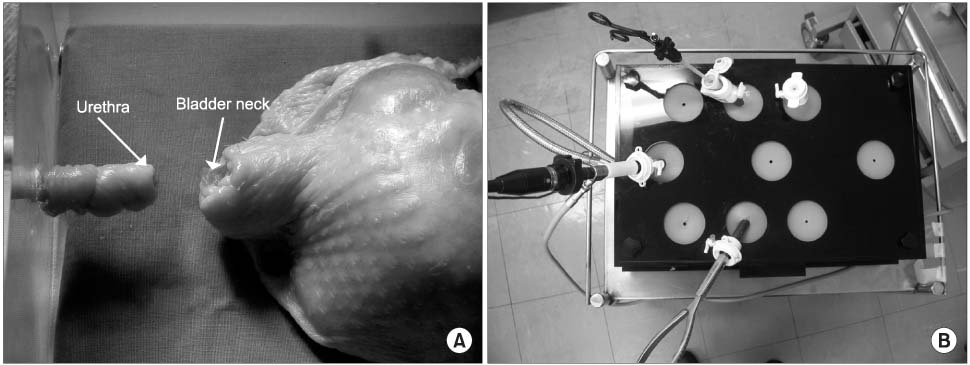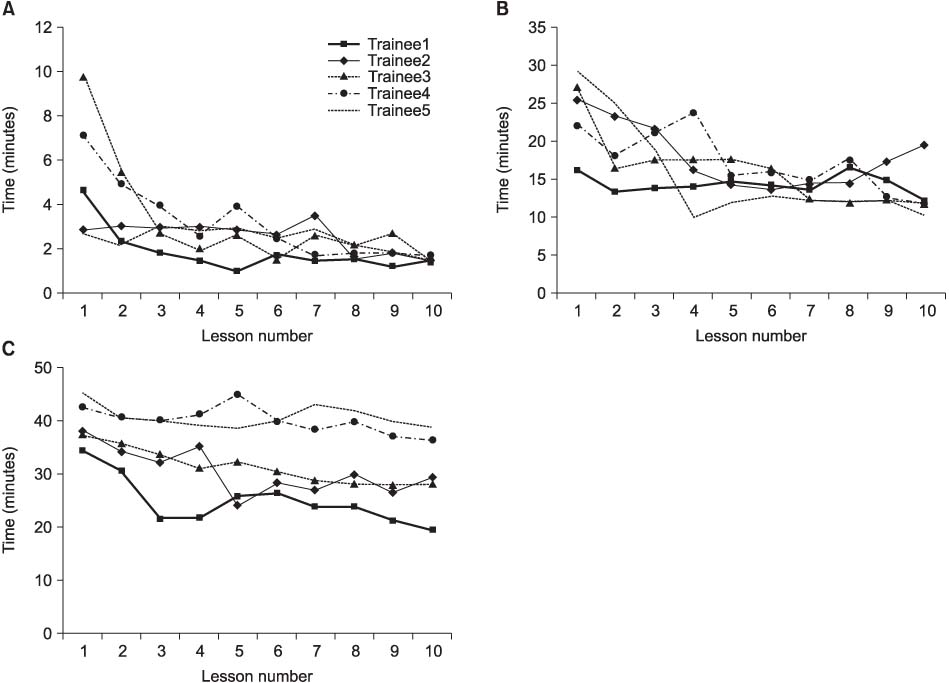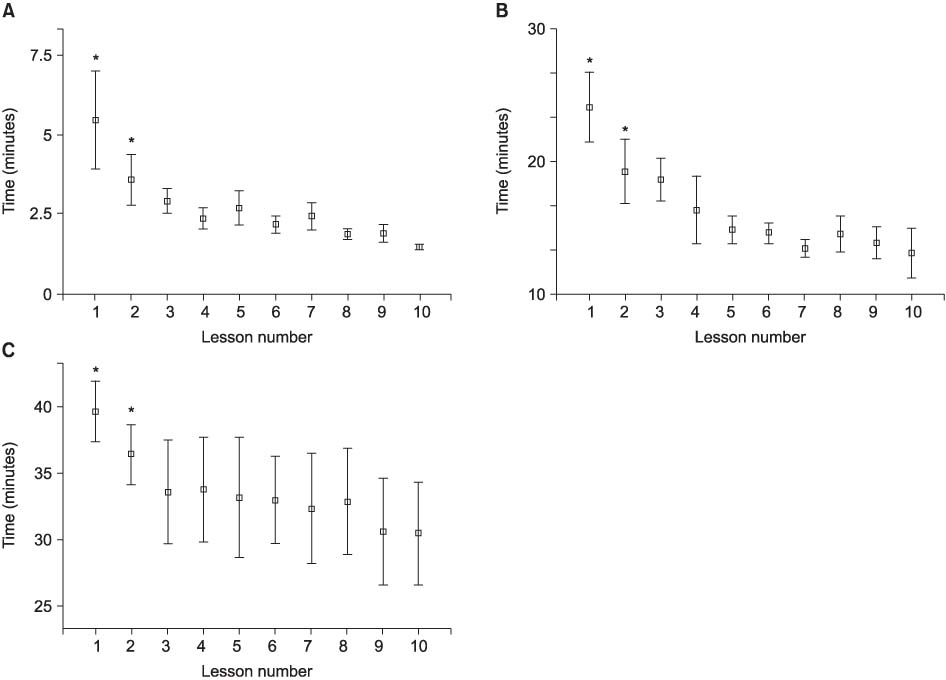Korean J Urol.
2006 Apr;47(4):407-411. 10.4111/kju.2006.47.4.407.
A Model and a Program for Training Laparoscopic Urethrovesical Anastomosis
- Affiliations
-
- 1Department of Urology, School of Medicine, Kyung Hee University, Seoul, Korea.
- KMID: 1997152
- DOI: http://doi.org/10.4111/kju.2006.47.4.407
Abstract
- PURPOSE
A model and a program was developed for training surgeons in laparoscopic urethrovesical anastomosis in order to improve the laparoscopic suture technique for urologists with no previous experience.
MATERIALS AND METHODS
The procedures were performed on a pelvic trainer using a videolaparoscopic unit. The program consisted of a simple suture, urethrovesical anastomosis with interrupted sutures, and urethrovesical anastomosis with continuous sutures. The trainees enrolled in this study were 5 residents from the urologic department who had little experiences in laparoscopic suturing. The trainees performed each procedure 10 times and the elapsed time was recorded. Univariate analysis of the general linear model was used to assess the significance of progression.
RESULTS
In the first lesson of the simple suture, the mean elapsed time was 5.45+/-3.00 minutes (range 2.78-9.83minutes) and each trainee demonstrated a difference in the elapsed time for suturing. After the tenth lesson was complete, the mean elapsed time was 1.48+/-0.17 minutes (range 1.35- 1.70 minutes) and the time differences between each trainee decreased. In urethrovesical anastomosis with interrupted sutures, the mean elapsed time decreased from 24.07+/-3.97 minutes at the 1st lesson (range 16.13- 29.47 minutes) to 13.10+/-2.53 minutes (range 11.75-19.47 minutes) after 10 lessons. In urethrovesical anastomosis with continuous sutures, the mean time decreased from 39.61+/-3.60 minutes (range 34.41-45.71 minutes) after one lesson to 30.42+/-5.75 minutes (range 19.50-38.82 minutes) after 10 lessons. There were significant differences in the elapsed time up to the 2nd lesson compared with the 10th lesson in all procedures (p-value<0.05). CONCLUSIONS: The skills of the trainee can be improved by a model and a program for training laparoscopic urethrovesical anastomosis. In particular, urethrovesical anastomosis, in which many urologists find difficulty, may become more accessible using this model and program.
Keyword
Figure
Cited by 1 articles
-
Assessment of the Laparoscopic Training Validity of a Virtual Reality Simulator (LAP MentorTM)
Tae Hyo Kim, Jung Min Ha, Jae Wook Cho, Youn Chul You, Gyung Tak Sung
Korean J Urol. 2009;50(10):989-995. doi: 10.4111/kju.2009.50.10.989.
Reference
-
1. Schuessler WW, Schulam PG, Clayman RV, Kavoussi LR. Laparoscopic radical prostatectomy: initial short-term experience. Urology. 1997. 50:854–857.2. Guillonneau B, Vallancien G. Laparoscopic radical prostatectomy: the Montsouris technique. J Urol. 2000. 163:1643–1649.3. Lee CH, Seo SI, Kim JC, Hwang TK. Laparoscopic radical prostatectomy. Korean J Urol. 2003. 44:617–623.4. Hoznek A, Salomon L, Rabii R, Ben Slama MR, Cicco A, Antiphon P, et al. Vesicourethral anastomosis during laparoscopic radical prostatectomy: the running suture method. J Endourol. 2000. 14:749–753.5. Shalhav AL, Dabagia MD, Wagner TT, Koch MO, Lingeman JE. Training postgraduate urologists in laparoscopic surgery: the current challenge. J Urol. 2002. 167:2135–2137.6. Kim TH, Sung GT, Cho WY. Development of laparoscopic training protocol using small animal model in urology. Korean J Urol. 2005. 46:741–749.7. Scott DJ, Young WN, Tesfay ST, Frawley WH, Rege RV, Jones DB. Laproscopic skills training. Am J Surg. 2001. 182:137–142.8. Fried GM, Derossis AM, Bothwell J, Sigman HH. Comparison of laparoscopic performance in vivo with performance measured in a laparoscopic simulator. Surg Endosc. 1999. 13:1077–1081.9. Scott DJ, Bergen PC, Rege RV, Laycock R, Tesfay ST, Valentine RJ, et al. Laparoscopic training on bench models: better and more cost effective than operating room experience? J Am Coll Surg. 2000. 191:272–283.10. Traxer O, Gettman MT, Napper CA, Scott DJ, Jones DB, Roehrborn CG, et al. The impact of intense laparoscopic skills training on the operative performance of urology residents. J Urol. 2001. 166:1658–1661.
- Full Text Links
- Actions
-
Cited
- CITED
-
- Close
- Share
- Similar articles
-
- In vivo porcine training model of laparoscopic common bile duct repair with T-tube insertion under the situation of iatrogenic common bile duct injury
- Laparoscopic Radical Prostatectomy
- In vivo porcine training model for laparoscopic Roux-en-Y choledochojejunostomy
- Intracorporeal Anastomosis in Laparoscopic Gastric Cancer Surgery
- Development of Laparoscopic Training Protocol Using Small Animal Model in Urology




